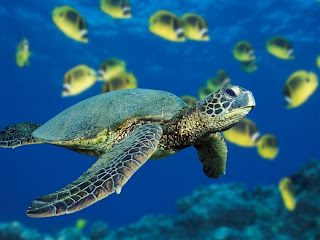1. We're not "Pew supporters." We're Friends of the Monument, supporters of marine conservation, people who want to preserve and protect our natural world.
2. The concept behind the project has been written about extensively--it's marine conservation. Some people have obviously missed all of the information that has been circulated about the benefits of marine conservation throughout the CNMI--not just recently, but for years. We have a lot of information, both from scientific studies and from our own experiences with the ocean.
3. The Marianas Trench Marine Monument project is essentially a project to have the U.S. Exclusive Economic Zone (EEZ) waters around Uracas, Maug, and Asuncion declared a Monument, making them a federally protected marine sanctuary. The CNMI Constitution has already made the islands themselves a CNMI land sanctuary. The proposal, if adopted, would extend the same type of protection the CNMI has given to the islands into the waters, and provide for both CNMI enforcement and federal enforcement and funding.
Photo from Loling Manahane's blog.
Here's a very brief synopsis of the "concept behind the project":
The world's oceans are in rapid decline. (Read the transcript of Dr. David Suzuki from the movie Empty Ocean, Empty Nets, available at habitat media online.)
It's likely to get worse: 77% of our oceans fisheries have already been fully exploited, overfished, or exhausted, based on information from the United Nations Food and Agriculture Organization; and estimates by an international team of university research scientists over a 4 year period conclude that by 2048, 90% of all (edible)marine life will be gone. (Reported in Science journal, and by many popular media like USA Today.)
Overfishing is the main reason that our marine ecosystems are depleted.
The vast majority of scientific consensus is that the main agent of change in the oceans as far as fish populations is concerned is fishing.
Dr. Carl Safina, National Audobon Society's Living Oceans Program
(Read about the problems, history, and potential solutions by the noted fisheries expert Dr. Daniel Pauly and others at the independent resource, overfishing.org.)
Overfishing continues to deplete our oceans, despite the regulations and enforcement by WESPAC and other U.S. federal (and other nation's) agencies.
Regulations at present are still too weak, faulty in their premises, and poorly enforced because of politics, underfunding of science, and other problems. (Read the film transcript of Dr. Vaughan Anthony from the New England Fisheries Management Council on how politicians get in the way of science and frustrate fisheries management; how regulations in the past weren't enforced; how our current regulations still don't create inefficiencies and tie-the-hands of fishermen enough.)
We need our marine life, and it's not inexhaustible.
There is an end to a resource. There's no unlimited supply of fish. You keep nibbling away at it, eventually you're going to get 'em all, or almost all of them. So you've got to be very careful.
Edwin Fuglvog, commercial fisherman, Alaska
Fixing the regulatory system will help, but it is not enough alone. (This is the concept of not-putting-all-your-eggs-in-one-basket that Mike Tripp has written about.)
One of the few proven methods of species recovery is the creation of no-take ocean reserves (sanctuaries, monuments). (Read the film transcript of Callum Roberts, the Harvard University Marine Conservation professor.)
The proposal is to create a no-take marine reserve around our three northernmost islands, and still allow fishing around all of the other islands--meeting our commitment to the Micronesian Challenge, and doing our part to help ourselves, our future generations, and the world.
The Marianas Trench is a beautiful, almost pristine, and unique eco-system that is worth protecting. Designating the waters around Uracas, Maug, and Asuncion as a National Marine Monument will make it a protected marine conservation area under NOAA sanctuaries program.
And voila! Because there already is a tremendous amount of scientific evidence that protected marine areas help conserve, preserve, and restore marine eco-systems, we can expect that our Marianas Trench Monument would have the same ecological, environmental effect.
That's the "meat" of the proposal and the "substantial proof" of the concept behind it.
All other potential benefits--global recognition that will act as free advertising for our tourism industry, federal funds coming in here for a Visitor's Center that could enhance the tourist experience, scientific research that will add to our knowledge of our unique Marianas Trench, spillover education benefits from scientists present in the CNMI, etc.--are gravy. They appear to be logical and likely consequences of designation of a Monument here.
But in essence, saving our ocean life by creating a marine sanctuary that is a well-documented means of preserving and restoring healthy eco-systems--that is the proven concept behind the proposal.














1 comment:
I support Pew! :} They do good work.. outside of supporting monument proposal.
I read Mr. Davies letter.. alot of bullhockey to me. "Proof of concept".. here it is - If you don't kill something, it lives, and likely breeds, providing a small chain reaction up the food chain. Multiply this times the number of living things in each square foot of the proposed monument X the entire cubic footage of the proposed monument.. you end up with alot of life.
There's the "proof of concept". As Ambrose would say.. "it's common sense".
I'm not a scholarly woman.. but it pains me to read something from someone trying to talk scholarly. If you can't.. don't try to. Talk how you know best to talk.
Post a Comment